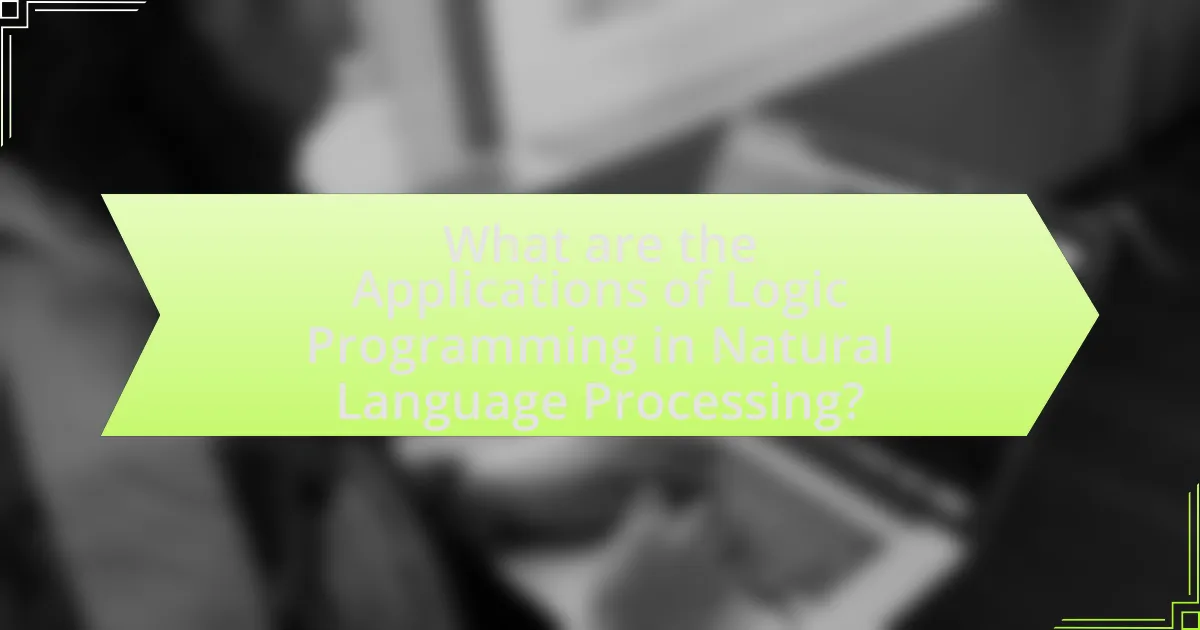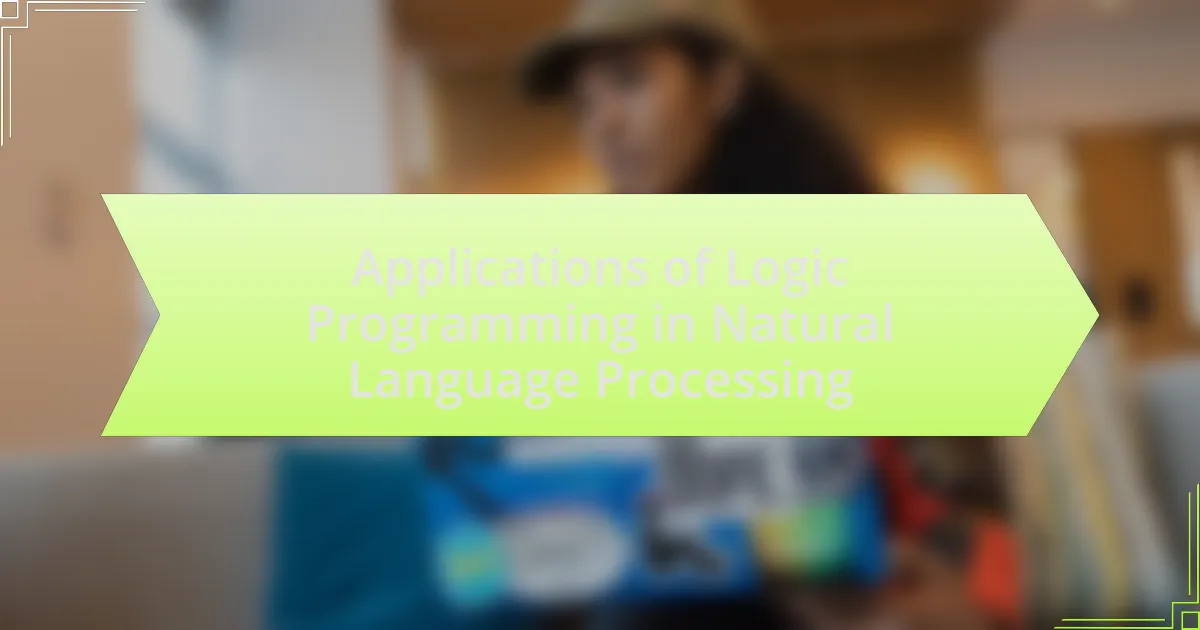Logic programming is a crucial component in the field of Natural Language Processing (NLP), applied in various tasks such as syntactic parsing, semantic interpretation, and knowledge representation. It provides a formal framework that enhances Natural Language Understanding (NLU) by enabling systems to represent and reason about linguistic knowledge, thereby improving the handling of ambiguities and complexities in language. Key techniques such as unification, backtracking, and constraint satisfaction are employed to facilitate effective parsing and semantic analysis. Additionally, logic programming plays a significant role in Natural Language Generation (NLG) and dialogue systems, allowing for coherent text creation and improved context handling. Despite its advantages, challenges such as computational limitations and the inherent complexity of natural language must be addressed for successful implementation in NLP projects.

What are the Applications of Logic Programming in Natural Language Processing?
Logic programming is applied in Natural Language Processing (NLP) primarily for tasks such as syntactic parsing, semantic interpretation, and knowledge representation. In syntactic parsing, logic programming facilitates the construction of grammars that can represent complex sentence structures, enabling systems to analyze and understand linguistic constructs effectively. For semantic interpretation, logic programming allows for the representation of meaning through formal logic, which aids in disambiguating sentences and understanding context. Additionally, knowledge representation in NLP leverages logic programming to encode facts and rules about the world, enabling systems to reason about language and make inferences. These applications demonstrate the effectiveness of logic programming in enhancing the capabilities of NLP systems.
How does Logic Programming contribute to Natural Language Understanding?
Logic programming contributes to Natural Language Understanding (NLU) by providing a formal framework for representing and reasoning about linguistic knowledge. This framework allows for the creation of rules and facts that can be used to infer meaning from natural language inputs. For instance, Prolog, a common logic programming language, enables the development of grammars that can parse sentences and derive their semantic interpretations through logical inference. Research has shown that logic-based approaches can effectively handle ambiguities and complexities in language, as demonstrated in studies like “Logic Programming for Natural Language Processing” by Pereira and Shieber, which illustrates how logic programming can model syntactic and semantic structures in language.
What are the key techniques used in Logic Programming for Natural Language Understanding?
The key techniques used in Logic Programming for Natural Language Understanding include unification, backtracking, and constraint satisfaction. Unification allows for the matching of terms and structures, enabling the system to infer relationships and meanings from sentences. Backtracking facilitates the exploration of multiple possible interpretations of a sentence, ensuring that all potential meanings are considered. Constraint satisfaction techniques help in resolving ambiguities by applying rules and constraints to narrow down the possible interpretations based on context. These techniques are foundational in enabling systems to parse and understand natural language effectively, as evidenced by their application in various logic-based NLP frameworks and systems.
How does Logic Programming improve semantic analysis in Natural Language Processing?
Logic programming enhances semantic analysis in Natural Language Processing (NLP) by providing a formal framework for representing knowledge and reasoning about language. This approach allows for the creation of rules and facts that can be used to infer meanings and relationships within text, facilitating more accurate interpretation of semantics. For instance, Prolog, a common logic programming language, enables the encoding of complex linguistic structures and relationships, which can improve disambiguation and context understanding in sentences. Studies have shown that systems utilizing logic programming can outperform traditional methods in tasks such as semantic parsing and question answering, demonstrating its effectiveness in enhancing the precision of semantic analysis in NLP applications.
What role does Logic Programming play in Natural Language Generation?
Logic Programming plays a crucial role in Natural Language Generation (NLG) by providing a formal framework for representing knowledge and reasoning about language. This approach allows for the generation of coherent and contextually appropriate sentences based on logical rules and facts. For instance, systems like Prolog utilize logic programming to define grammar rules and semantic relationships, enabling the automatic generation of text that adheres to syntactic and semantic constraints. The effectiveness of Logic Programming in NLG is evidenced by its application in various systems that produce natural language outputs from structured data, demonstrating its capability to handle complex linguistic tasks efficiently.
How can Logic Programming facilitate the creation of coherent text?
Logic programming facilitates the creation of coherent text by enabling the formal representation of knowledge and rules that govern language structure. This approach allows for the systematic generation of sentences based on logical inferences, ensuring that the output adheres to grammatical and semantic constraints. For instance, Prolog, a prominent logic programming language, can be used to define relationships and rules that guide text generation, resulting in coherent narratives that maintain logical consistency. Research has shown that systems utilizing logic programming can effectively model linguistic phenomena, thereby enhancing the coherence and relevance of generated text.
What are the advantages of using Logic Programming for text generation tasks?
Logic Programming offers several advantages for text generation tasks, primarily through its declarative nature, which allows for clear expression of relationships and rules. This clarity facilitates the generation of coherent and contextually relevant text by enabling the system to reason about the information it processes. Additionally, Logic Programming supports backtracking, which allows for the exploration of multiple potential outputs and the selection of the most appropriate one based on defined criteria. This capability enhances the flexibility and creativity of generated text. Furthermore, the use of formal logic ensures consistency and correctness in the generated content, as it adheres to well-defined rules and structures. These advantages make Logic Programming a powerful tool in Natural Language Processing applications, particularly in generating structured and meaningful text.
How does Logic Programming enhance dialogue systems?
Logic programming enhances dialogue systems by providing a formal framework for representing knowledge and reasoning about language. This approach allows dialogue systems to process complex queries and infer meanings based on logical rules, improving their ability to understand user intent. For instance, systems can utilize Prolog, a common logic programming language, to manage dialogue states and generate contextually relevant responses. Research has shown that logic-based dialogue systems can achieve higher accuracy in understanding user inputs compared to traditional rule-based systems, as they can dynamically adapt to new information and user interactions.
What are the components of a dialogue system that benefit from Logic Programming?
The components of a dialogue system that benefit from Logic Programming include the dialogue management module, natural language understanding (NLU), and natural language generation (NLG). The dialogue management module utilizes Logic Programming to maintain the state of the conversation and manage the flow of dialogue based on logical rules. NLU benefits from Logic Programming by enabling the system to parse and interpret user inputs through formal representations of language, allowing for more accurate understanding of user intents. NLG employs Logic Programming to generate coherent and contextually appropriate responses by applying logical rules to construct sentences that align with the dialogue context. These components leverage the formalism and reasoning capabilities of Logic Programming to enhance the overall effectiveness and efficiency of dialogue systems.
How does Logic Programming improve the handling of context in conversations?
Logic Programming enhances the handling of context in conversations by enabling the representation and manipulation of knowledge in a structured format. This structured approach allows for the explicit encoding of contextual information, such as relationships and dependencies between different pieces of information. For instance, Prolog, a common logic programming language, uses facts and rules to infer new information based on existing data, which helps maintain context throughout a dialogue.
Research indicates that systems utilizing Logic Programming can effectively manage ambiguous language and resolve references by applying logical inference, thus improving the coherence and relevance of responses in conversational agents. This capability is evidenced by studies demonstrating that logic-based systems outperform traditional methods in understanding context, as they can dynamically adjust their responses based on the evolving conversation.
What are the challenges faced when applying Logic Programming in Natural Language Processing?
The challenges faced when applying Logic Programming in Natural Language Processing include issues related to ambiguity, complexity of natural language, and performance limitations. Ambiguity arises because natural language often has multiple interpretations, making it difficult for logic-based systems to derive a single, correct representation. The complexity of natural language, with its intricate syntax and semantics, poses additional hurdles, as logic programming requires precise definitions that may not capture the nuances of human language. Performance limitations are also significant, as logic programming can be computationally intensive, leading to slower processing times compared to other approaches like statistical methods. These challenges highlight the difficulties in effectively integrating logic programming into NLP applications.
How do computational limitations affect the use of Logic Programming?
Computational limitations significantly restrict the effectiveness of Logic Programming by impacting its efficiency and scalability. Logic Programming relies on backtracking and unification processes, which can become computationally expensive, especially with large datasets or complex queries. For instance, the exponential time complexity associated with certain algorithms can lead to performance bottlenecks, making it impractical for real-time applications in Natural Language Processing. Additionally, memory constraints can hinder the ability to handle extensive knowledge bases, limiting the scope of problems that can be effectively addressed. These factors collectively reduce the applicability of Logic Programming in scenarios requiring rapid processing and large-scale data handling.
What are the common pitfalls in implementing Logic Programming for NLP tasks?
Common pitfalls in implementing Logic Programming for NLP tasks include inefficiency in handling large datasets, difficulty in integrating with probabilistic models, and challenges in representing ambiguity and context. Logic Programming often struggles with scalability, as traditional logic-based systems can become computationally expensive when processing extensive linguistic data. Additionally, NLP tasks frequently require probabilistic reasoning to manage uncertainty, which Logic Programming does not inherently support, leading to integration issues. Furthermore, natural language is inherently ambiguous and context-dependent, making it difficult for rigid logic-based systems to accurately capture the nuances of human language. These challenges highlight the limitations of Logic Programming in effectively addressing the complexities of NLP tasks.
How can one effectively implement Logic Programming in NLP projects?
To effectively implement Logic Programming in NLP projects, one should utilize Prolog or similar languages to represent knowledge and infer relationships. This approach allows for the creation of rule-based systems that can process natural language by defining grammar rules and semantic interpretations. For instance, Prolog’s backtracking mechanism can efficiently handle ambiguity in language, enabling the system to explore multiple interpretations of a sentence. Additionally, integrating Logic Programming with other NLP techniques, such as machine learning, can enhance the system’s ability to learn from data while maintaining logical consistency. This combination has been shown to improve tasks like information extraction and question answering, as evidenced by research demonstrating that logic-based frameworks can outperform traditional methods in specific NLP applications.
What best practices should be followed when using Logic Programming for NLP?
When using Logic Programming for Natural Language Processing (NLP), best practices include ensuring clarity in the representation of knowledge, utilizing efficient algorithms for parsing and inference, and maintaining modularity in code design. Clarity in knowledge representation allows for better understanding and manipulation of linguistic structures, which is crucial for tasks like semantic parsing. Efficient algorithms, such as those based on Prolog, enhance performance in processing complex queries and reasoning tasks, as evidenced by their application in systems like SWI-Prolog, which is optimized for NLP tasks. Modularity in code design facilitates easier maintenance and scalability, allowing developers to adapt and extend systems without significant rework, as seen in successful NLP projects that leverage logic-based frameworks.
What tools and frameworks are recommended for Logic Programming in Natural Language Processing?
Prolog and Answer Set Programming (ASP) are recommended tools and frameworks for Logic Programming in Natural Language Processing. Prolog is widely used for its ability to handle symbolic reasoning and complex queries, making it suitable for tasks like natural language understanding and generation. ASP, on the other hand, excels in non-monotonic reasoning and is effective for knowledge representation and reasoning tasks in NLP. Both frameworks have been validated through numerous applications in the field, demonstrating their effectiveness in processing and interpreting natural language data.



